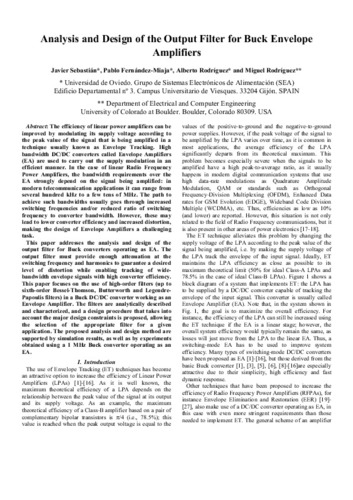Analysis and design of the output filter for buck envelope amplifiers
Fecha de publicación:
Editorial:
Institute of Electrical and Electronics Engineers (IEEE)
Versión del editor:
Citación:
Descripción física:
Resumen:
The efficiency of linear power amplifiers can be improved by modulating its supply voltage according to the peak value of the signal that is being amplified in a technique usually known as envelope tracking. High bandwidth dc/dc converters called envelope amplifiers (EAs) are used to carry out the supply modulation in an efficient manner. In the case of linear RF power amplifiers, the bandwidth requirements over the EA strongly depend on the signal being amplified: in modern telecommunication applications it can range from several hundred kilohhertzs to a few tens of megahertz. The path to achieve such bandwidths usually goes through increased switching frequencies and/or reduced ratio of switching frequency to converter bandwidth. However, these may lead to lower converter efficiency and increased distortion, making the design of EAs a challenging task. This paper addresses the analysis and design of the output filter for Buck converters operating as EA. The output filter must provide enough attenuation at the switching frequency and harmonics to guarantee a desired level of distortion while enabling tracking of wide-bandwidth envelope signals with high converter efficiency. This paper focuses on the use of high-order filters (up to sixth-order Bessel-Thomson, Butterworth, and Legendre-Papoulis filters) in a buck dc/dc converter working as an EA. The filters are analytically described and characterized, and a design procedure that takes into account the major design constraints is proposed, allowing the selection of the appropriate filter for a given application. The proposed analysis and design method are supported by simulation results, as well as by experiments obtained using a 1 MHz buck converter operating as an EA
The efficiency of linear power amplifiers can be improved by modulating its supply voltage according to the peak value of the signal that is being amplified in a technique usually known as envelope tracking. High bandwidth dc/dc converters called envelope amplifiers (EAs) are used to carry out the supply modulation in an efficient manner. In the case of linear RF power amplifiers, the bandwidth requirements over the EA strongly depend on the signal being amplified: in modern telecommunication applications it can range from several hundred kilohhertzs to a few tens of megahertz. The path to achieve such bandwidths usually goes through increased switching frequencies and/or reduced ratio of switching frequency to converter bandwidth. However, these may lead to lower converter efficiency and increased distortion, making the design of EAs a challenging task. This paper addresses the analysis and design of the output filter for Buck converters operating as EA. The output filter must provide enough attenuation at the switching frequency and harmonics to guarantee a desired level of distortion while enabling tracking of wide-bandwidth envelope signals with high converter efficiency. This paper focuses on the use of high-order filters (up to sixth-order Bessel-Thomson, Butterworth, and Legendre-Papoulis filters) in a buck dc/dc converter working as an EA. The filters are analytically described and characterized, and a design procedure that takes into account the major design constraints is proposed, allowing the selection of the appropriate filter for a given application. The proposed analysis and design method are supported by simulation results, as well as by experiments obtained using a 1 MHz buck converter operating as an EA
ISSN:
Patrocinado por:
Ministerio de Educación y Ciencias de España, en el marco de Consolider Project RUE CSD2009-00046, Project DPI2010- 21110-C02-0, and European Regional Development Fund (ERDF)
Colecciones
Ficheros en el ítem





